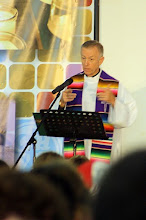They were saints originally honored especially in the Eastern Empire; their traditional site of burial is Syria. The church in Rome, though, is of special interest in light of political turmoil today.

Its vestibule (these days, not used) is actually the so-called "Temple of Romulus" adjacent to the House of the Vestal Virgins in the Forum. This temple is thought to have been built to honor the son of Maxentius, the rival of Constantine who lost the battle of Saxa Ruba (the "Milvian Bridge"). And so Pope Felix IV in dedicating it to these saints did what many other bishops of Rome would do: convert ancient pagan monuments into churches (most famously, perhaps, the Pantheon). This accomplished several purposes: it helped to celebrate the triumph of Christianity over paganism in the City of Rome; it helped preserve great examples of ancient art and architecture; and it gave a canvas, so to speak, for artists to create their own magnificent works of art, especially (in this period) mosaics.
The alternative would have been razing these temples with the ground. This, I take it, would have been a great loss. Even in their ruined state they are amazing and awe-some (it only takes a few minutes standing inside what is left of the "Basilica of Maxentius and Constantine," next door to Ss Cosmas and Damian, to understand this).
The trouble is that this is exactly what the Turks did in the middle of the 15th century when they conquered Constantinople. They turned the glorious church of Hagia Sophia (Holy Wisdom) into a mosque. Is this different, and if so, why?
Actually, it is in one important aspect: by the time the bishops of Rome chose to convert pagan shrines into Christian ones, paganism was a long-forgotten memory. The whole of Rome (and the Empire, for practical purposes) was Christian (at least in name). This was not, and is not, the case in Constantinople (modern-day Istanbul): the Greek Orthodox are very much alive and around, and it is a pain beyond belief to them to see their great mother-church used in this way.
Think how western Catholics would feel if the same thing happened to St Peter's in Rome...
Having said all that, I am glad that when I was a student in Rome I could give historical tours of the original Roman Forum and appreciate the artistic Christian wonders produced inside their re-purposed buildings. Perhaps I am more blessed than many by this two-fold gift--I am certainly grateful for it! Thanks to the Chicago Jesuits who made sure our education was classical as well as Christian.
On the top of this post are the two external views of the old Roman and now Christian building; below are view of the apse mosaic inside. Enjoy!




